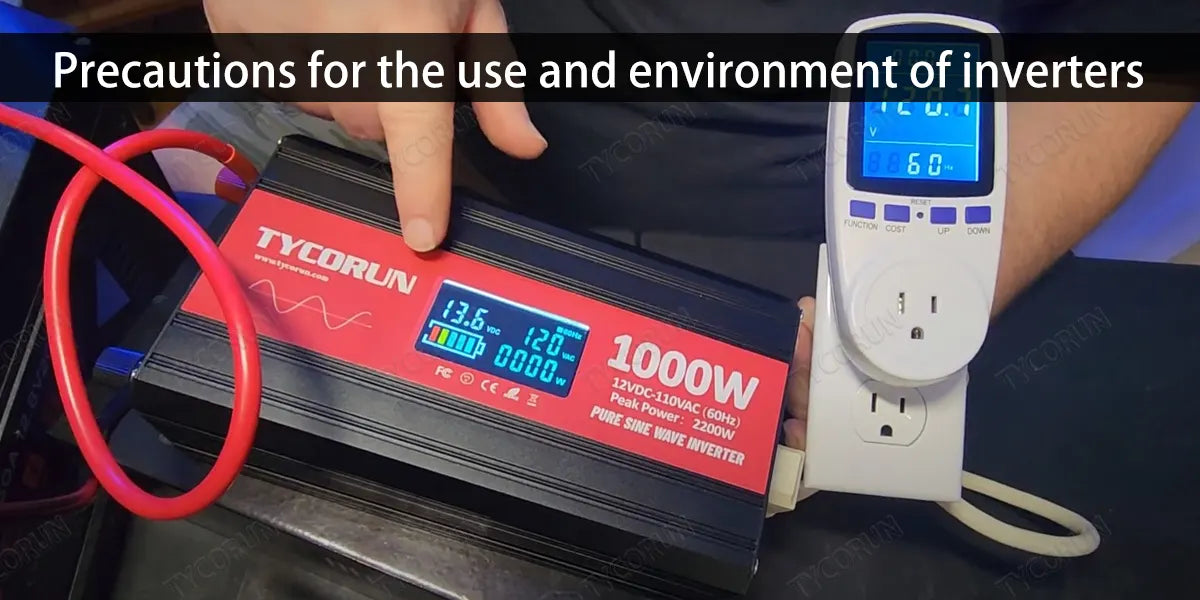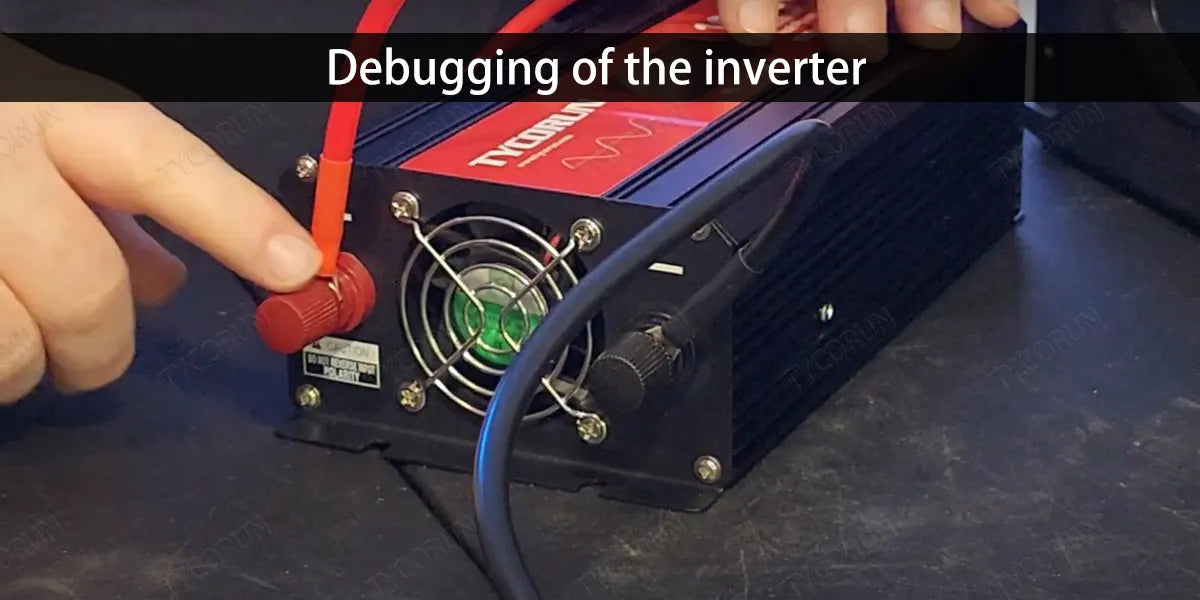
The inverter, like 2000w pure sine wave inverter or 3000 watt solar inverter, is an important part of the photovoltaic system, and its performance directly affects the quality of power generation.
So how to do inverter maintenance on a daily basis? What should you pay attention to when using an inverter? This article will list some suggestions for inverter maintenance and daily use for your reference.
Main content:
Five safety rules for using inverters
When performing inverter maintenance or inspection, to ensure the safety of the operators, please be sure to comply with the following five safety rules:
- Disconnect all external connections from the inverter and from the device’s internal power supply.
- Make sure the inverter is not accidentally powered back on.
- Use a multimeter to ensure that the inverter is completely de-energized.
- Perform necessary grounding and short-circuit connections.
- Use insulating cloth to insulate and cover potentially live parts near the operating part.

Precautions for the use and environment of inverters
- Connect and install the equipment strictly in accordance with the requirements of the inverter operation and inverter maintenance instructions.
- During installation, you should carefully check: whether the wire diameter meets the requirements; whether the components and terminals are loose during transportation; whether the insulated parts are well insulated; whether the system's grounding meets the regulations.
- Should strictly operate and process inverter maintenance in accordance with the provisions of the inverter manual. Before turning on the machine, pay attention to check whether the input voltage is normal; during operation, pay attention to whether the sequence of turning on and off the machine is correct, and whether the indications of each meter and indicator light are normal.
- Inverters generally have automatic protection for circuit breakage, overcurrent, overvoltage, overheating, etc., so when these phenomena occur, there is no need to shut down manually; the protection points for automatic protection are generally set at the factory, and there is no need to make adjustments.
- There is high voltage in the inverter cabinet. Operators are generally not allowed to open the cabinet door, and the cabinet door should be locked at all the time.
- When the room temperature exceeds 30℃, heat dissipation and cooling measures should be taken to prevent equipment failure and extend the service life of the equipment.
- Observe whether the inverter is damaged or deformed.
- Listen to check if there are any abnormal sounds when the inverter is running.
- When the system is running on the grid, check various variables.
- Check whether the main components are normal.
- Check whether the inverter shell is heating normally and use a thermal imager.
- Wait to monitor the heating status of the system.
- Observe whether the air inlet and outlet is normal.
- Check the humidity, dust, and all air in the environment around the inverter.
- Check whether the inlet filter is functioning normally. Note that the ventilation of the air inlet must be checked. Otherwise, if the module cannot be effectively cooled, it will fail due to overheating.

Inverter daily maintenance
- The inverter product requires very little inverter maintenance, and the LFP battery only needs to be kept charged regularly to obtain the expected life. When connected to the mains, it always charges the battery regardless of whether it is turned on or not, and provides overcharge and over-discharge protection functions.
- If the inverter device is not used for a long time, it is recommended to charge it every four to six months for inverter maintenance. Under normal circumstances, the service life of the 12V battery is 3-5 years. If it is found to be in poor condition, it must be replaced immediately. When replacing the battery, it must be done by professionals. Batteries should not be replaced individually. When replacing batteries as a whole, the instructions of the battery supplier should be followed.
- Before replacing the battery, the equipment must be turned off, disconnected from the mains power, and the battery switch must also be turned off. Take off metal items such as rings and watches. Use insulated handles and screwdrivers, and do not place tools or other metal objects on the battery pack.
- When connecting the battery cable, it is normal for small sparks to appear at the joint and will not cause harm to personal safety or equipment. Never short-circuit the positive and negative terminals of the battery or reverse the connection.
- Attention! Ventilation of the air inlets must be checked for inverter maintenance. Otherwise, if the module cannot be effectively cooled, it will fail due to overheating.

Debugging of the inverter
Power circuit connection
- For inverter maintenance, debugging should be carried out half a year after the first commissioning, and then every six months to one year.
- Check if the power cable connection is loose and tighten it again according to the previously specified torque.
- Check whether the power cable and control cable are damaged.
- Check Whether there are traces of cuts on the skin in contact with the metal surface.
- Check whether the insulation wrapping tape of the power cable terminal has fallen off.
Terminal and cable connection
- For inverter maintenance, terminal and cable connections need to be inspected once a year.
- Check if the control terminal screws are loose and tighten them with a screwdriver.
- Check whether the main circuit terminals have poor contact and whether there are signs of overheating at the screw locations.
- Visually inspect connections such as equipment terminals and cable distribution.

Inverter periodic maintenance
System cleaning
For inverter maintenance, system cleaning of the inverter only needs to be done every six months to one year, depending on the dust content of the usage environment. Please pay attention to the following points when proceeding system cleaning:
- Check the cleanliness of circuit boards and components.
- Check the radiator temperature and dust. If necessary, use compressed air and turn on the fan to clean the module.
- Replace the air filter. Cooling fan maintenance and replacement.
- The inverter cooling fan needs to be inspected once a year.
- Check whether there are cracks in fan blades.
- Listen to confirm if there is any abnormal vibration sound when the fan is running. If there is any abnormality in the fan, it must be replaced in time.
- The circuit breaker needs to be inspected every six months for inverter maintenance.
- Perform routine checks on all metal components for corrosion.
- Annual inspection of contactors (auxiliary switches and micro switches) to ensure that their mechanical operation is in good condition.
- Check operating parameters (especially voltage and insulation)
- The safety function of the inverter needs to be checked every six months to one year.
- Check the emergency stop button and LCD stop function.
- Simulate shutdown and check shutdown signal communication.
- Check warning labels and replace if necessary.
The above is the basic content related to inverter maintenance. It should be noted that even for the top 10 solar inverters, most inverter maintenance work requires removing the protective grille inside the machine. After all inverter maintenance work is completed, the protective grille must be replaced.
The actual inverter maintenance cycle should be reasonably customized based on the specific installation environment of the product. If the operating environment is windy or dusty, it is necessary to shorten the inverter maintenance cycle and increase the inverter maintenance frequency.
You can check our Tycorun inverter products if needed: car inverter 3000w, 2000 watt pure sine wave inverter, 1000w car inverter, 500 w power inverter
Related posts: 12 volt 100ah lithium battery, 12V 6ah lithium ion batteries, lawn mower battery